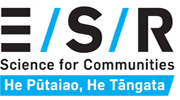What is biowaste and why is it important?
Biowaste is any solid or liquid organic, biodegradable waste. This includes organic industrial waste, agricultural waste, liquid and solid waste from sewage, food waste, green bin waste, and greywater (all wastewater that originates from bath, showers, hand basins and laundry).

An illustration of where greywater comes from in a house
Biowaste makes up more than half of the total waste going to landfill in Aotearoa New Zealand. About 322,000 tonnes of biowaste are put into the landfill annually— that’s more than 16x the weight of the Auckland sky tower! Landfilling is not a viable long-term management option for all that biowaste, and it is also becoming more difficult due to increased waste levies, lack of space and long transportation distance, and regional environmental and economic issues. Further when biowaste breaks down in a landfill, it releases harmful greenhouse gases that contribute to climate change. Dumping liquid biowaste into waterways also causes problems like algal blooms that pollute water and harm native ecosystems. In response, central government has created policy aimed at minimising and developing sustainable use options for biowaste.
However, the main issue with diverting biowaste from landfill is that alternative solutions are not always simple and can pose challenges for regulatory agencies. Creating a safe and sustainable biowaste management system requires a multi-disciplinary approach, because of the mix of social, economic, environmental, infrastructural, political and cultural factors involved. A first step to safe and sustainable biowaste management is to reimagine biowaste as a resource, rather than as waste that gets dumped onto land or into water. Unlike many other waste streams, there are good options for alternative, economical, and beneficial use for biowastes.
Biowaste is carbon-rich and generally contains high concentrations of valuable nutrients. If properly treated and/or processed, biowaste can become a sustainable addition to soil with the potential to increase water holding capacity, the presence of beneficial organisms, and essential plant nutrients, and so improve overall soil quality. For example, the use of biowaste in soil could also reduce reliance on inorganic fertilisers for plant nutrients. In fact, the amount of nutrients in the biowaste we produce annually is equivalent to about 400,000 tonnes of fertilizer! Further options for reusing biowaste include energy production, restoration of ecosystem services, and transformation to valuable products using insects.
What we do
The biowaste team at ESR investigates ways that biowaste can be re-used, instead of losing the valuable biological and chemical resources it contains. To help create a circular economy for biowaste, we conduct research that evaluates ways that biowaste can be minimised, converted, and re-used. To address this challenge, we work transdisciplinary with soil and plant scientists, ecologists, microbiologists, social scientists and kaupapa māori researchers. Current research is examining how insects can be used to transform biowaste to a variety of valuable products.
Another one of our research aims is investigating the use of native ecosystems to manage biowaste. Research from our team has shown that native plants can grow well when irrigated with wastewater and when biosolids are applied to soil. Not only that, but native plants can improve water and soil quality by preventing runoff of nutrients and contaminants, while also improving soil habitat for microbes and invertebrates.
ESR’s biowaste team working the field to study how to use waste to establish New Zealand’s native vegetation and improve water quality.
We work with central and local government, regional councils, iwi, communities and stakeholders to build innovative and fit-for-purpose solutions for the sustainable re-use of biowaste and help to develop national guidelines for beneficial applications of organic waste to land. Our community engagement approach helps us to integrate local knowledge and develop solutions that are culturally appropriate and have enduring community support, in addition to being scientifically sound. To collaborate with us, contact ESR scientist Maria Jesus Gutierrez Gines.
